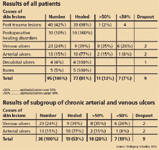- Acne
- Actinic Keratosis
- Aesthetics
- Alopecia
- Atopic Dermatitis
- Buy-and-Bill
- COVID-19
- Case-Based Roundtable
- Chronic Hand Eczema
- Chronic Spontaneous Urticaria
- Drug Watch
- Eczema
- General Dermatology
- Hidradenitis Suppurativa
- Melasma
- NP and PA
- Pediatric Dermatology
- Pigmentary Disorders
- Practice Management
- Precision Medicine and Biologics
- Prurigo Nodularis
- Psoriasis
- Psoriatic Arthritis
- Rare Disease
- Rosacea
- Skin Cancer
- Vitiligo
- Wound Care
Article
Study shows shock wave therapy helps heal various skin lesions
Vienna, Austria — A new study suggests that extracorporeal shock wave therapy (ESWT) is highly effective in treating patients with several types of skin lesions, including venous ulcers and burns.
Vienna, Austria - A new study suggests that extracorporeal shock wave therapy (ESWT) is highly effective in treating patients with several types of skin lesions, including venous ulcers and burns.
Researchers presented their findings at the 8th International Congress on Shock Wave Therapy in Vienna.

Researchers in Vienna and Berlin treated participants' skin lesions with ESWT between September 2004 and January 2005. They used low energy flow densities - depending on the defect size, with the number of impulses varying from a few hundred to several thousand. No anesthesia was necessary, because they used a defocused shock wave.
"We did not use anesthesia, antibiotics (unless participants were already taking them) or debridement," Dr. Schaden says. "We just used shock wave therapy to treat the skin lesions."
They report that 81 percent of skin lesions reached complete healing and 12 percent healed more than 50 percent. Out of the 36 chronic venous and arterial ulcers treated in the study, 19, or 53 percent, healed within six to 12 weeks, and 10 such wounds showed more than 50 percent epithelialization. Ninety-eight percent of the post-trauma lesions healed, while 100 percent of the postoperative healing disorders, decubital ulcers and burns healed. Thirty-nine percent of the venous ulcers and 77 percent of the arterial ulcers healed.
The researchers also reported there was a lessening of infection after the first treatment.
"We know from in vitro trials that there is a high antibacterial effect of shock wave, perhaps because of the influence the therapy has on biofilms that are produced by the bacteria," Dr. Schaden says. "Shock waves seem to crack that and to make it easier for the body to fight infection. Clinically, what we saw was that, after the first therapy, inflammation really decreased without our having to use antibiotics."
None of the participants experienced any worsening of their wounds. Nine people dropped out of the study for reasons other than therapy side effects or lack of treatment success, according to the researchers.
It appears, according to Dr. Schaden, that shock wave therapy brings all-important blood supply back to the damaged tissue, allowing healing to take place.
Background
Before embarking on the human trial on shock wave therapy and skin lesions, Dr. Schaden and colleagues had been using shock wave therapy on non-healing sectors of bones, or nonunions.
"After having enough experience, we also used it on infected nonunions, with osteomyelitis, and those fractures are very often combined with soft tissue, such as skin lesions, fistulas, and so on," Dr. Schaden says. "We would observe, as a side effect, an extremely quick healing of those wounds after shock wave therapy."
New area for dermatologists
shock wave therapy might be novel to dermatologists, but its use is mainstream to urologists, who have been using the therapy for 35 years to destroy kidney stones.
Dr. Schaden and colleagues developed a special therapy head to apply Shock waves on the skin.
"The therapy head has a silicone membrane that you apply directly to the body of the patient, and we changed this head to have defocused Shock waves, which are plain waves that do not hurt and do not require anesthesia. We applied that directly to the surface of the wound," he explains.
Newsletter
Like what you’re reading? Subscribe to Dermatology Times for weekly updates on therapies, innovations, and real-world practice tips.











